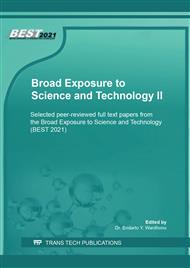p.129
p.136
p.144
p.155
p.161
p.167
p.176
p.189
p.197
Influence of Thermomechanical Treatment on the Microstructure and Mechanical Properties of Cu-28Zn-4Mn Alloys
Abstract:
Cartridge case ammunition is made from brass alloy by deep drawing process with high degree of deformation. For this reason, the material with a good formability, strength, and hardness is required. The improvement of mechanical propeties of the brass alloy can be conducted by severe process such as addition of alloying element and also termomechanical process. The purpose of this study is to determine the effect thermomechanical processing by cold rolling process with 70% thickness reduction followed by annealing process with variation temperature of 400°C, 500°C and 600°C for 30 minutes to the microstructure and mechanical properties of Cu-28Zn-4Mn alloy. The samples of Cu-28Zn-4Mn alloy were produced by gravity die casting process by using the ingot of Cu, Zn as well as the Mn powder as the feeding materials. The investigation results show that thermomechanical prosess change the microstructures of Cu-28Zn-4Mn alloy. The cold rolling process with 70% thickness reduction will convert the equiaxial grain into an elongated structure (shear band). Furthermore, the heat treatment by annealing process will return the microstructure from elongated to equiaxial grain. Thermomechanical process also tends to change mechanical properties. The 70 % cold rolling process increases the hardness of the Cu-28Zn-4Mn alloy. The hardness of as homogenized and 70% cold rolled samples are 62.34 VHN and 103.96 VHN, respectively. Further, the annealing process tend to decrease the tensile strength and hardness of Cu-28Zn-4Mn alloy. Tensile strength of Cu-28Zn-4Mn after annealing process with variation of 400°C, 500°C, and 600°C are 355.13 MPa, 299.16 MPa, and 294.79 MPa, respectively. On the other hand, the hardness of Cu-28Zn-4Mn with the same treatment are 91.84 VHN, 71.76 VHN and 67.46 VHN, respectively. In contast, the annealing process tend to increase the elongation value. The samples elongation after the annealing process with variation of 400°C, 500°C, and 600°C are 25%, 28%, and 30%, respectively.
Info:
Periodical:
Pages:
161-166
Citation:
Online since:
March 2022
Authors:
Keywords:
Price:
Сopyright:
© 2022 Trans Tech Publications Ltd. All Rights Reserved
Share:
Citation:


